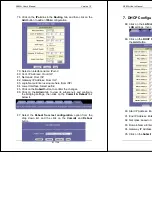
X8824r User’s Manual Version 1.0
69 / 102
10.10 Management control
Click on the
Management control
link to enable access to
configuration manager from the WAN port.
The table on this page provides a check box to enable or
disable HTTP (i.e., Web browser-based) access to the
configuration program through the WAN port. In the
Inactivity
TimeOut
text box, you can specify a length of time in minutes
after which external access will be blocked, assuming that there
is no access during that time.
10.11 Autodetect
Click on the
Autodetect
link which enables the modem to
automatically detect and configure a valid ATM VC at startup.
Autodetect eliminates the need to have users configure VC
values.
Autodetect can be used to establish PPPoE, PPPoA,
IPoA-1577 and EoA connections and can be configured in
either of two modes:
bridging
mode and
routing
mode. These
modes are specific to the Autodetect feature and are configured
in addition to the system operating mode defined on the
modem.
X8824r User’s Manual Version 1.0
70 / 102
When Autodetect is configured in
bridging
mode, it can detect
the presence of PPPoE and EoA interfaces on the access
server. In this mode, the modem must be configured as a
bridge and a PPPoE or DHCP client is expected to be running
on the LAN PC (behind the modem).
When configured in
routing
mode, Autodetect can
detect PPPoE, EoA, PPPoA, or IPoA-1577 interfaces on the
access server. Autodetect searches for these interfaces in that
order. Depending on the interface detected, Autodetect creates
a PPP, EoA, or IPoA interface on the modem. In this mode, the
modem is expected to be configured as a router.
Click on the
Submit
button when completed and make sure to
Commit & Reboot
.
10.12 SNMP
Click on the
SNMP
link to configure the SNMP trap settings.
The Simple Network Management Protocol (SNMP) enables a
host computer to access configuration, performance, and other
system data that resides in a database on the modem. The host
computer is called a management station and the modem is
called an SNMP agent. The data that can be accessed via
SNMP is stored in a Management Information Database (MIB)
on the modem.
When SNMP is enabled, the modem responds to SNMP
requests from the host. The host may ask to read data from the
MIB or, when its privileges allow, write data to it.
















































